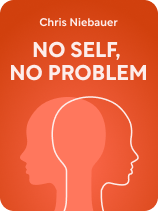

This article is an excerpt from the Shortform book guide to "No Self, No Problem" by Chris Niebauer. Shortform has the world's best summaries and analyses of books you should be reading.
Like this article? Sign up for a free trial here.
How do you perceive yourself? What if your sense of self was just an illusion created by your brain?
In his book No Self, No Problem, Chris Niebauer explores questions such as these and offers practical strategies for shifting your perception. He helps readers understand that their thoughts and feelings don’t define them—and that letting go of a fixed identity can lead to a happier, more flexible life.
Read on to discover how you can change the way you see yourself and experience more freedom and joy.
How to Change the Way You See Yourself
It’s one thing to know that believing too strongly that your thoughts and feelings are real—and that they create a sense of self that’s really “you”—is an error. It’s another thing to figure out how to go about changing the way you see yourself and how you’ve always perceived reality in general. Fortunately, Niebauer can help. In the book, he provides a variety of short exercises and prompts to kickstart this process. We’ll explore three of the most important strategies he recommends focusing on if you want to learn to take the stories of your left brain a little less seriously and build a happier life in the process.
#1: Realize That Your “Self” Is Just an Illusion
The first step to letting go of the narrative your left brain constructs for you is simply to realize that the “self” you think you know (and are) is just an illusion. Seeing this illusion for what it is can help free you from the constraints of the identity you’ve built for yourself. This means you’ll be able to approach your life with more flexibility, adaptability, and openness to new experiences. For example, you might think of yourself as a city person. But if you let go of that identity, you’ll feel more willing to go beyond city limits and see what it would be like to travel to the country or spend a summer in the suburbs. By becoming more open to possibility, you stop letting an idea define what you do or limit the experiences you’re open to.
(Shortform note: It’s one thing to want to let go of your ideas about yourself—and another to figure out how to do it. In Waking Up, philosopher and neuroscientist Sam Harris suggests one way to transcend the illusion of the self is to cultivate a meditation practice. When you meditate, you can explore your consciousness in a way that helps you see through the impression that you’re defined by your thoughts and feelings. Harris says learning to meditate is a long journey, but enables you to experience consciousness without your thoughts, feelings, and memories intruding. The goal is to be present in the moment so you can look beyond your ideas about yourself and feel more open to the world as it really is—at least for a few moments at a time.)
Niebauer points out that, once you understand that your sense of self is just an illusion, rather than something fixed and stable, you can realize the same thing applies to other people, too. It’s easy to stereotype people or to think you know what their personalities or tendencies are. But other people’s characters and inner lives are as complex and ever-changing as your own thoughts, emotions, behaviors, and temperament. Niebauer explains that knowing nobody else has a fixed self can help you practice empathy for others and feel grateful for what you experience with the people you love, without the burden of rigid expectations for what kind of person the other should be.
(Shortform note: Perhaps without realizing it, many of us fall into the implicit assumption philosophers call solipsism: the feeling you’re the only sentient being because you can’t prove that other people’s consciousnesses exist. Rational Mysticism author John Horgan says this skepticism of others’ consciousness is a reaction to our sense of solitude or isolation. It poses a barrier to practicing the empathy that Niebauer champions since it causes us to dismiss other people’s perspectives. But Horgan says that by using art to imagine others’ lives or by getting to know another person well, you can confront your solipsism and be more aware of other people’s minds—as complex and as ever-changing as Niebauer notes they are.)
#2: Learn That You Aren’t Your Thoughts or Feelings
Niebauer explains that coming to understand the narrative of the “self” as an illusion can also set you on a path toward discovering one of the core insights of mindfulness: the idea that you aren’t your thoughts or feelings. (Shortform note: Mindfulness is a nonjudgmental awareness of the thoughts, emotions, and sensations you’re experiencing in the present moment. The idea is to learn there isn’t a “right” or “wrong” way for you to feel or think, and to accept the present moment instead of dwelling on the past or obsessing over the future. Structured meditation is one way to practice mindfulness; other techniques include focusing on your breathing or paying special attention to the present moment by engaging all your senses.)
According to Niebauer, if you can let go of the tendency to identify yourself with what you’re thinking or feeling, then you can observe your thoughts and emotions from a distance instead of accepting them as real. Then you can learn to handle them more objectively, which can reduce the stress and anxiety you feel in your everyday life. He recommends practicing mindfulness to cultivate the skill of being awake to everything you’re experiencing in the present moment, without trying to judge it, apply labels to it, or fit it into a neat narrative about yourself or the world. Rather than getting lost in past memories or future anxieties, you can strive to have lucid moments where you’re just experiencing the present.
(Shortform note: In The Happiness Trap, therapist Russ Harris explains that a core idea in Acceptance and Commitment Therapy (ACT)—a mindfulness-based therapy that often parallels Buddhist ideas—is cognitive defusion. The first step in ACT is to become aware that your thoughts are just thoughts, and they don’t necessarily tell the truth about you or the world. The next step is to separate yourself from your thoughts, using cognitive defusion to recognize your thoughts as stories your brain tells you and nothing more. Practicing cognitive defusion means recognizing yourself as an observer of your thoughts, emotions, and judgments. As an observer, you don’t have any obligation to those experiences beyond simply acknowledging they exist.)
#3: Choose the Middle Path
Niebauer explains that, once you know intellectually that the self is an illusion, you can choose among three paths. The first path leads you right back to the status quo, where you identify yourself with the voice in your head and let your left brain tell you what story to believe about yourself and your world. At the other extreme, the second path leads you to a life filled with meditation training, mindfulness practice, yoga instruction, and prayer, where you dedicate your time to using these tools to try to transcend your narrative-based way of seeing the world.
The third path is what Buddhists call the middle path because it offers a compromise between the other two. Niebauer says that when you take this path, you still live your life letting your left brain construct its narratives and make its judgments. But you also cultivate the ability to take those stories less seriously. Likewise, while you might practice meditation, mindfulness, or yoga to exercise the muscle of seeing things with your right brain rather than your left, you also spend time just living your everyday life.
Choosing the middle path, as Niebauer describes it, is like allowing yourself to get caught up in a captivating novel, even though you know it’s just a story. From time to time, you’ll lose yourself in the action and feel the joys and disappointments of your life deeply. Other times, you’ll remember they’re all part of the story your left brain tells. You’ll be able to step back and watch as if from a distance, experiencing everything that comes your way without clinging too strongly to your left brain’s judgments of events and experiencing a much calmer and more open approach to life.
Exercise: Watch Your Thoughts Come and Go
One of Niebuaer’s key pieces of advice—informed by both neuroscience and Buddhism—is to recognize that your thoughts, judgments, emotions, and perceptions aren’t you: They’re just temporary things you can learn to observe and let pass.
- Sit in a comfortable position, take a deep breath, and notice the thoughts going through your head. (You might find it helpful to close your eyes, or to focus them gently on a still point across the room.) Just watch your thoughts coming and going, like they’re people getting on and off trains at a subway station. After a minute or so, write down a few of the thoughts you noticed.
- Take a look at the thoughts you wrote down. How many of them feel like you? How many of them sound like someone else altogether? How many do you feel ambivalent about?
- Sit for another minute or two to again observe your thoughts come and go. Notice how you might identify more strongly with some than with others. Is it easier to let some of them go than others? How might you practice the skill of distancing yourself from your thoughts and judgments in your everyday life?

———End of Preview———
Like what you just read? Read the rest of the world's best book summary and analysis of Chris Niebauer's "No Self, No Problem" at Shortform.
Here's what you'll find in our full No Self, No Problem summary:
- Why everything you know about yourself is wrong
- How science is catching on to what Eastern religions have been teaching for millenia
- How to loosen your grip on the thoughts and judgments that make you dissatisfied with your reality






